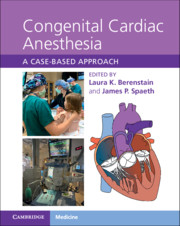Book contents
- Congenital Cardiac Anesthesia
- Congenital Cardiac Anesthesia
- Copyright page
- Dedication
- Contents
- Contributors
- Introduction
- Chapter 1 A Congenital Heart Disease Primer
- Section 1 Left-to-Right Shunts
- Section 2 Right-Sided Obstructive Lesions
- Section 3 Left-Sided Obstructive Lesions
- Section 4 Complex Mixing Lesions
- Section 5 Single-Ventricle Physiology
- Section 6 Heart Failure, Mechanical Circulatory Support, and Transplantation
- Section 7 Miscellaneous Lesions and Syndromes
- Chapter 40 Idiopathic Pulmonary Hypertension
- Chapter 41 Pulmonary Hypertension and Congenital Heart Disease
- Chapter 42 Pulmonary Hypertension and Prematurity
- Chapter 43 Pulmonary Hypertension and Moyamoya Disease
- Chapter 44 Vascular Ring
- Chapter 45 Pericardial Effusion
- Chapter 46 Kawasaki Disease
- Chapter 47 VACTERL Syndrome
- Chapter 48 Hurler Syndrome
- Chapter 49 Long QT Syndrome
- Chapter 50 Marfan Syndrome
- Index
- References
Chapter 49 - Long QT Syndrome
from Section 7 - Miscellaneous Lesions and Syndromes
Published online by Cambridge University Press: 09 September 2021
- Congenital Cardiac Anesthesia
- Congenital Cardiac Anesthesia
- Copyright page
- Dedication
- Contents
- Contributors
- Introduction
- Chapter 1 A Congenital Heart Disease Primer
- Section 1 Left-to-Right Shunts
- Section 2 Right-Sided Obstructive Lesions
- Section 3 Left-Sided Obstructive Lesions
- Section 4 Complex Mixing Lesions
- Section 5 Single-Ventricle Physiology
- Section 6 Heart Failure, Mechanical Circulatory Support, and Transplantation
- Section 7 Miscellaneous Lesions and Syndromes
- Chapter 40 Idiopathic Pulmonary Hypertension
- Chapter 41 Pulmonary Hypertension and Congenital Heart Disease
- Chapter 42 Pulmonary Hypertension and Prematurity
- Chapter 43 Pulmonary Hypertension and Moyamoya Disease
- Chapter 44 Vascular Ring
- Chapter 45 Pericardial Effusion
- Chapter 46 Kawasaki Disease
- Chapter 47 VACTERL Syndrome
- Chapter 48 Hurler Syndrome
- Chapter 49 Long QT Syndrome
- Chapter 50 Marfan Syndrome
- Index
- References
Summary
Congenital long QT syndrome is a group of genetically transmitted disorders characterized by abnormal cardiac repolarization resulting in QT interval prolongation that predisposes patients to the acute onset of ventricular arrhythmias, most notably torsades de pointes, which may cause syncope or sudden cardiac death. Long QT syndrome is usually transmitted in an autosomal dominant pattern. Diagnosis remains challenging, as roughly 40% of patients with genotype-positive LQTS do not demonstrate QT prolongation on resting ECG. Clinical manifestations are heterogenous and include presyncope, syncope, aborted cardiac arrest, cardiac arrest, and sudden cardiac death but many patients are completely asymptomatic. Many of the medications administered during an anesthetic affect the QT interval. Additionally, patients with long QT syndrome may require the placement of pacemakers, implantable cardioverter-defibrillators and/or cardiovascular implantable electronic devices. This chapter discusses the perioperative management of patients with long QT syndrome and appropriate management of implanted devices during the perioperative period.
Keywords
- Type
- Chapter
- Information
- Congenital Cardiac AnesthesiaA Case-based Approach, pp. 374 - 385Publisher: Cambridge University PressPrint publication year: 2021



